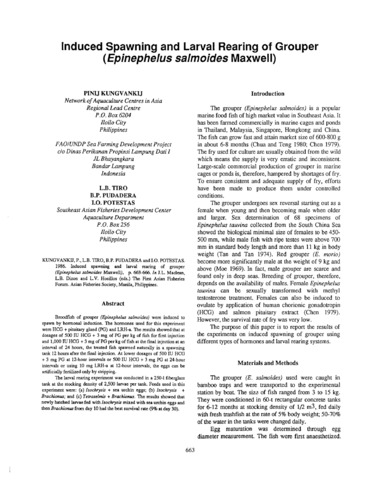Induced spawning and larval rearing of grouper (Epinephelus salmoides Maxwell)
Share
Abstract
Broodfish of grouper (Epinephelus salmoides ) were induced to spawn by hormonal induction. The hormones used for this experiment were HCG + pituitary gland (PG) and LRH-a. The results showed that at dosages of 500 IU HCG + 3 mg of PG per kg of fish for first injection and 1,000 IU HCG + 3 mg of PG per kg of fish at the final injection at an interval of 24 hours, the treated fish spawned naturally in a spawning tank 12 hours after the final injection. At lower dosages of 500 IU HCG + 3 mg PG at 12-hour intervals or 500 IU HCG + 3 mg PG at 24-hour intervals or using 10 mg LRH-a at 12-hour intervals, the eggs can be artificially fertilized only by stripping. The larval rearing experiment was conducted in a 250-l fiberglass tank at the stocking density of 2,500 larvae per tank. Feeds used in this experiment were: (a) Isochrysis + sea urchin eggs; (b) Isochrysis + Brachionus ; and (c) Tetraselmis + Brachionus . The results showed that newly hatched larvae fed with Isochrysis mixed with sea urchin eggs and then Brachionus from day 10 had the best survival rate (9% at day 30).
Suggested Citation
Kungvankij, P., Tiro, Jr., L. B., Pudadera Jr., B. J., & Potestas, I. O. (1986). Induced spawning and larval rearing of grouper (Epinephelus salmoides Maxwell). In J. L. Maclean, L. B. Dizon, & L. V. Hosillos (Eds.), The First Asian Fisheries Forum: proceedings of the First Asian Fisheries Forum, Manila, Philippines, 26-31 May 1986 (pp. 663-666). Manila, Philippines: Asian Fisheries Society.



